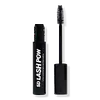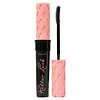What's inside
What's inside
 Key Ingredients
Key Ingredients

 Benefits
Benefits

 Concerns
Concerns

 Ingredients Side-by-side
Ingredients Side-by-side

Water
Skin ConditioningGlyceryl Stearate Se
EmulsifyingAlcohol Denat.
AntimicrobialHydrogenated Olive Oil Stearyl Esters
Emulsion StabilisingCopernicia Cerifera Wax
Synthetic Beeswax
Emulsion StabilisingVp/Eicosene Copolymer
Acacia Senegal Gum
MaskingPalmitic Acid
EmollientHydrated Silica
AbrasiveStearic Acid
CleansingPolybutene
Silica
AbrasiveStyrene/Acrylates Copolymer
Aminomethyl Propanediol
BufferingTri (Polyglyceryl-3/Lauryl) Hydrogenated Trilinoleate
EmulsifyingPhenoxyethanol
PreservativePanthenol
Skin ConditioningGlycerin
HumectantVp/Va Copolymer
Polyvinyl Alcohol
Propylene Glycol
HumectantEthylhexylglycerin
Skin ConditioningXanthan Gum
EmulsifyingPolyquaternium-10
Sodium Dehydroacetate
PreservativeCI 77499
Cosmetic ColorantWater, Glyceryl Stearate Se, Alcohol Denat., Hydrogenated Olive Oil Stearyl Esters, Copernicia Cerifera Wax, Synthetic Beeswax, Vp/Eicosene Copolymer, Acacia Senegal Gum, Palmitic Acid, Hydrated Silica, Stearic Acid, Polybutene, Silica, Styrene/Acrylates Copolymer, Aminomethyl Propanediol, Tri (Polyglyceryl-3/Lauryl) Hydrogenated Trilinoleate, Phenoxyethanol, Panthenol, Glycerin, Vp/Va Copolymer, Polyvinyl Alcohol, Propylene Glycol, Ethylhexylglycerin, Xanthan Gum, Polyquaternium-10, Sodium Dehydroacetate, CI 77499
Water
Skin ConditioningParaffin
PerfumingPolybutene
Cera Alba
EmollientBis-Diglyceryl Polyacyladipate-2
EmollientPalmitic Acid
EmollientStearic Acid
CleansingVp/Eicosene Copolymer
Acacia Senegal Gum
MaskingCopernicia Cerifera Wax
Aminomethyl Propanediol
Buffering1,2-Hexanediol
Skin ConditioningCaprylyl Glycol
EmollientSilica
AbrasiveEuphorbia Cerifera Wax
Hydroxyethylcellulose
Emulsion StabilisingPanthenol
Skin ConditioningButylene Glycol
HumectantHydroxyacetophenone
AntioxidantChlorphenesin
AntimicrobialPentylene Glycol
Skin ConditioningTocopheryl Acetate
AntioxidantAlgin
MaskingSerine
MaskingDisodium Phosphate
BufferingSodium Phosphate
BufferingPolysorbate 60
EmulsifyingIron Oxides
Water, Paraffin, Polybutene, Cera Alba, Bis-Diglyceryl Polyacyladipate-2, Palmitic Acid, Stearic Acid, Vp/Eicosene Copolymer, Acacia Senegal Gum, Copernicia Cerifera Wax, Aminomethyl Propanediol, 1,2-Hexanediol, Caprylyl Glycol, Silica, Euphorbia Cerifera Wax, Hydroxyethylcellulose, Panthenol, Butylene Glycol, Hydroxyacetophenone, Chlorphenesin, Pentylene Glycol, Tocopheryl Acetate, Algin, Serine, Disodium Phosphate, Sodium Phosphate, Polysorbate 60, Iron Oxides
 Reviews
Reviews

Ingredients Explained
These ingredients are found in both products.
Ingredients higher up in an ingredient list are typically present in a larger amount.
Acacia Senegal Gum has skin soothing, thickening, and formulation stabilizing properties. It comes from the Acacia tree that is native to sub-Saharan Africa.
We don't have a description for Aminomethyl Propanediol yet.
Copernicia Cerifera Wax comes from a palm tree native to Brazil; another name for this ingredient is Carnauba Wax.
This ingredient is used to thicken texture and also leaves behind a film when applied.
Fun fact: This wax has the highest melting point of all natural waxes and low solubility.
Learn more about Copernicia Cerifera WaxPalmitic Acid is a fatty acid naturally found in our skin and in many plant and animal sources. In cosmetics, it is usually derived from palm oil. It serves many purposes in skincare, acting as a cleanser, emollient, and emulsifier.
As an emollient, palmitic acid helps soften and smooth the skin by preventing water loss. In cleansers, it helps remove oil and dirt while creating foam.
Its emulsifying properties help stabilize products by keeping water and oil-based ingredients from separating.
This may not be suitable for fungal acne-prone skin, as fatty acids like this can sometimes trigger breakouts in sensitive individuals.
Learn more about Palmitic AcidPanthenol is a common ingredient that helps hydrate and soothe the skin. It is found naturally in our skin and hair.
There are two forms of panthenol: D and L.
D-panthenol is also known as dexpanthenol. Most cosmetics use dexpanthenol or a mixture of D and L-panthenol.
Panthenol is famous due to its ability to go deeper into the skin's layers. Using this ingredient has numerous pros (and no cons):
Like hyaluronic acid, panthenol is a humectant. Humectants are able to bind and hold large amounts of water to keep skin hydrated.
This ingredient works well for wound healing. It works by increasing tissue in the wound and helps close open wounds.
Once oxidized, panthenol converts to pantothenic acid. Panthothenic acid is found in all living cells.
This ingredient is also referred to as pro-vitamin B5.
Learn more about PanthenolPolybutene is used to help control the viscosity of a product. This just means it helps adjusts the texture.
It is a polymer and does not get absorbed into the skin due to its large size.
Studies found this ingredient did not irritate skin in concentrations below 15%.
Learn more about PolybuteneSilica, also known as silicon dioxide, is a naturally occurring mineral. It is used as a fine, spherical, and porous powder in cosmetics.
Though it has exfoliant properties, the function of silica varies depending on the product.
The unique structure of silica enhances the spreadability and adds smoothness, making it a great texture enhancer.
It is also used as an active carrier, emulsifier, and mattifier due to its ability to absorb excess oil.
In some products, tiny microneedles called spicules are made from silica or hydrolyzed sponge. When you rub them in, they lightly polish away dead skin layers and enhance the penetration of active ingredients.
Learn more about SilicaStearic Acid is a fatty acid. It is an emollient, emulsifier, and texture enhancer.
As an emollient, stearic acid helps soften skin. It aids the skin's protective barrier by preventing water loss. It also provides a gentle cleansing effect without stripping away natural oils.
Stearic acid may also be used to enhance the texture of products. It can add volume and stabilize ingredients such as water and oil. This can help water and oil ingredients from separating.
Sources of stearic acid include animal or vegetable fats/oils such as coconut or shea. It can be naturally found in butter, cocoa butter, shea butter, vegetable fats, and animal tallow.
This ingredient may not be Malassezia folliculitis, or fungal-acne safe.
Learn more about Stearic AcidWe don't have a description for Vp/Eicosene Copolymer yet.
Water. It's the most common cosmetic ingredient of all. You'll usually see it at the top of ingredient lists, meaning that it makes up the largest part of the product.
So why is it so popular? Water most often acts as a solvent - this means that it helps dissolve other ingredients into the formulation.
You'll also recognize water as that liquid we all need to stay alive. If you see this, drink a glass of water. Stay hydrated!
Learn more about Water